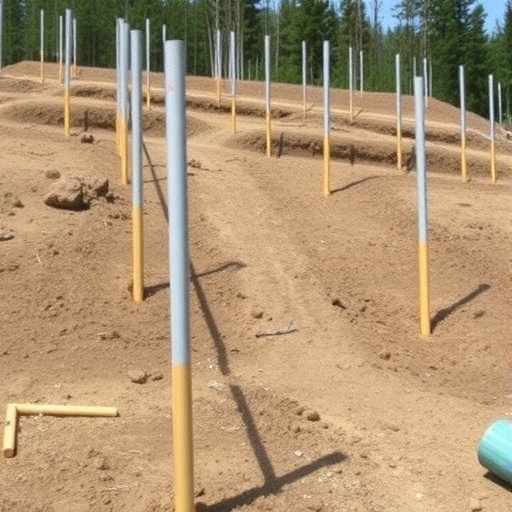In a surprising development that has sent ripples through the geotechnical and remote sensing research communities, a recent article published in Environmental Earth Sciences has been officially retracted. The paper, initially celebrated for its innovative approach to analyzing the reinforcement effect of piles on soil slopes, has now been withdrawn by the authors and the journal. This decision was accompanied by a retraction note formally issued in 2025, signaling a significant moment in the field’s ongoing dialogue about the reliability and transparency of numerical modeling techniques.
The original study, authored by Pang, B., Wang, Y., Xu, K., and colleagues, addressed a critical intersection of geotechnical engineering and remote sensing technology. Their work sought to quantify how pile reinforcements interact with both cohesive soils, known for their complex plastic behavior, and cohesionless soils, characterized by granular particle interactions and frictional resistance. This focus on understanding slope stability through sophisticated numerical simulations represented a fresh direction in mitigating landslide risks and subsidence in vulnerable landscapes.
However, the retraction implies that underlying methodological or analytical issues may have compromised the validity of the conclusions drawn. While the retraction note itself does not elaborate on specific faults, the situation underscores the inherent challenges in applying numerical analysis to soil-structure interaction problems. Accurate modeling of pile reinforcement effects requires not only detailed soil behavior characterization but also precise calibration of boundary conditions and validation against empirical data sets—factors known to be demanding within geotechnical research.
The use of remote sensing as an assisting tool in this context was a particularly novel aspect of the research. Remote sensing technologies, such as LiDAR and satellite-based imagery, offer powerful means to monitor slope deformations and environmental changes over large spatial and temporal scales. Integrating these data sources with advanced finite element or finite difference models can potentially revolutionize predictive maintenance and hazard mitigation strategies in slope engineering. The retracted study aimed to demonstrate this integration’s feasibility, but the recent withdrawal raises questions about the robustness of such multidisciplinary approaches.
From a technical perspective, simulating pile reinforcement effects involves capturing the interaction mechanics between rigid structural elements and deformable soil substrates under various loading conditions. Cohesive soils, with their tendency for plastic deformation and shear strength governed by cohesion and internal friction angle, require complex constitutive models to predict failure mechanisms accurately. Cohesionless soils, lacking adhesive forces, rely heavily on effective stress principles and granular flow mechanics, which present distinct modeling challenges.
The research also attempted to quantify the beneficial influence of piles in stabilizing slopes prone to failure due to gravitational forces and hydrological factors. By reinforcing weaker soil layers, piles can redistribute stress, enhance slope stiffness, and prevent displacement. Yet, numerical models must carefully account for pile-soil interface properties, including friction and adhesion, to capture realistic behavior. Any oversimplification or computational error in this regard can significantly impact predictive reliability, casting doubt on conclusions about reinforcement efficacy.
The decision to retract this pivotal work reminds the scientific community of the vital role that peer review, data transparency, and reproducibility play in maintaining research integrity. In interdisciplinary studies marrying geotechnical modeling with remote sensing analytics, these principles become even more crucial, given the complexity and novelty of combining disparate data types and analytical frameworks. As such, the retraction may serve as a catalyst for establishing more rigorous standards in future investigations.
Moreover, this episode highlights the importance of continuous validation and calibration of numerical models using field observations and laboratory experiments. While numerical simulation offers unparalleled flexibility and insight into soil-structure interaction phenomena, it is inherently limited without empirical grounding. Models must be iteratively refined through real-world feedback loops to ensure their outputs are reliable for engineering decision-making.
In light of the retraction, researchers in geotechnical engineering and remote sensing are encouraged to revisit assumptions underlying their modeling approaches, particularly when addressing slope stabilization strategies. This includes considering heterogeneity in soil properties, dynamic environmental loads such as rainfall and seismic activity, and the nonlinear behavior of reinforcement elements under critical stress conditions. Enhanced computational resources and improved data acquisition methods should be leveraged to achieve these aims.
Furthermore, this development sheds light on the evolving nature of scientific understanding in earth sciences. The iterative process of publication, critique, correction, and sometimes withdrawal is intrinsic to scientific progress. Far from representing failure, retractions signify a commitment to the highest standards of accuracy and responsibility. The community’s response to such events often ultimately strengthens consensus and informs better practices.
As this case leaves numerous questions unanswered, it acts as a reminder of the imperative need for interdisciplinary collaboration. Geotechnical engineers, remote sensing experts, numerical modelers, and field practitioners must work closely to align methodologies, verify outputs, and translate findings into actionable solutions for slope management and hazard reduction.
Looking ahead, the fusion of advanced remote sensing data with robust numerical simulations remains a promising frontier. When executed with rigor and transparency, such integrated approaches could enable early warning systems for landslides, optimize design of slope reinforcement structures, and promote sustainable infrastructure development in challenging terrains globally.
In conclusion, the retraction of the paper by Pang et al. serves as a notable event in environmental earth sciences, revealing both the potential and the pitfalls of using numerical analysis to assess pile reinforcement effects on soil slopes. It emphasizes the necessity for meticulous methodological scrutiny, empirical validation, and open science practices in advancing this critical area of research. The journey towards safer, more resilient slopes continues, informed by lessons learned from this reflective moment in scientific inquiry.
Subject of Research: Numerical analysis of pile reinforcement effects on cohesive and cohesionless soil slopes with applications in remote sensing-assisted engineering.
Article Title: Retraction Note: Numerical analysis of pile reinforcement effect on cohesive and cohesionless soil slopes for assisting remote sensing.
Article References:
Pang, B., Wang, Y., Xu, K. et al. Retraction Note: Numerical analysis of pile reinforcement effect on cohesive and cohesionless soil slopes for assisting remote sensing. Environ Earth Sci 84, 660 (2025). https://doi.org/10.1007/s12665-025-12700-8
Image Credits: AI Generated




